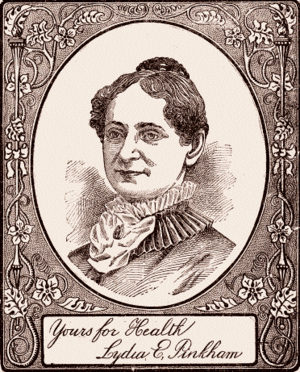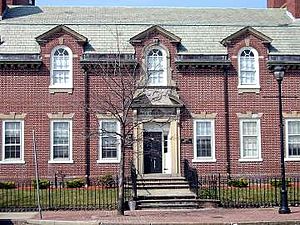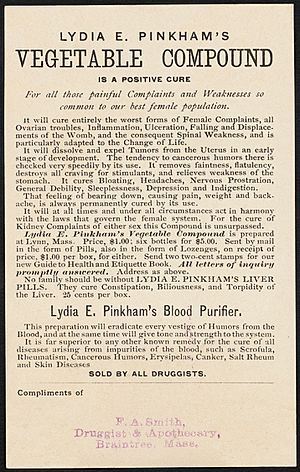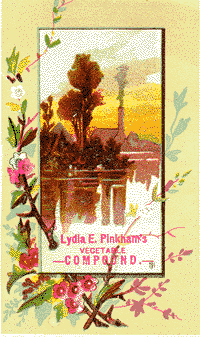Lydia Pinkham facts for kids
Quick facts for kids
Lydia E. Pinkham
|
|
|---|---|

Pinkham, from a 1904 pamphlet
|
|
| Born |
Lydia Estes
February 9, 1819 Lynn, Massachusetts, U.S.
|
| Died | May 17, 1883 (aged 64) |
Lydia Estes Pinkham (born Estes; February 9, 1819 – May 17, 1883) was an American woman who created and sold a special herbal "women's tonic." This medicine was very popular, even though some medical experts thought it was a "fake remedy." You can still buy a changed version of her product today!
Contents
Lydia Pinkham's Early Life
Lydia Pinkham was born in Lynn, Massachusetts, in 1819. She was one of twelve children. Her family, the Estes, were Quakers, a religious group known for their simple lifestyle. Lydia's father was a shoemaker who became wealthy by buying and selling land.
Lydia went to Lynn Academy for her education. Before she got married in 1843, she worked as a schoolteacher.
A Family Against Slavery
The Estes family strongly believed in ending slavery. This was called abolitionism. They were also against separating people based on their race. A famous leader against slavery, Frederick Douglass, was a neighbor and friend of their family. Many abolitionist leaders would meet at the Estes' home.
Lydia joined the Lynn Female Anti-slavery Society when she was just sixteen. She supported the idea of feminism, which means believing in equal rights for women. Her own children would also continue to work against slavery.
Marriage and Family Life
In 1843, Lydia married Isaac Pinkham, who made shoes. Isaac tried different businesses, but he didn't have much success. Lydia and Isaac had four children who survived: Charles, Daniel, William, and Aroline. All of her children would later help with the family medicine business.
Creating a Special Remedy
Like many women of her time, Lydia Pinkham made home remedies. She collected many recipes for these medicines. Her special remedy for "female complaints" became very popular with her neighbors. She often gave it away for free.
Some people say her husband got the recipe as payment for a debt. The ingredients in her remedy were herbs that people knew about from books like John King's American Dispensary, which Lydia owned.
Why Home Remedies Were Popular
Back in Lydia's time, doctors were very expensive. Most Americans could only afford to see a doctor in an emergency. Also, some of the medicines doctors used could be dangerous. For example, a common "medicine" called calomel was actually a poison!
Because of this, many people trusted "root and herb" healers more. They especially trusted women like Lydia who shared their homemade remedies.
Starting the Pinkham Business
In the early 1870s, Isaac Pinkham lost all his money. The family had a hard time. So, in 1875, they decided to turn Lydia's popular remedy into a family business.
Lydia first made the medicine on her kitchen stove. But it became so successful that they moved production to a factory. She also wrote letters to customers and probably created most of the advertisements.
A Famous Medicine and Smart Marketing
Starting in 1876, Lydia E. Pinkham's Vegetable Compound became one of the most famous patent medicines of the 1800s. You can still find products based on her original recipe today.
Lydia was very good at marketing her product directly to women. Her company continued her smart marketing ideas even after she died. Her own face was on the label of the medicine. The company also used many testimonials from grateful women who said the medicine helped them.
Letters from Customers
Advertisements encouraged women to write to Lydia Pinkham. And they did! They received answers to their letters. People kept writing and getting answers for many years after Lydia herself had passed away.
These letters, written by staff, talked openly about women's health issues. They gave advice and, of course, suggested using the company's product. In 1905, a magazine called Ladies' Home Journal showed a picture of Lydia Pinkham's tombstone. This showed that Lydia could not have been answering the letters herself. The Pinkham company said they never meant to trick anyone. They said the letters were answered by Lydia's daughter-in-law, Jennie Pinkham.
Lydia Pinkham's Legacy
Even though Lydia Pinkham started her business to make money, many modern-day feminists admire her. They see her as a champion for women's health. This was important because women often didn't get good medical care back then.
The Lydia Pinkham House in Lynn, Massachusetts, is now a historic place. In 1922, Lydia's daughter, Aroline, started the Lydia E. Pinkham Memorial Clinic. This clinic in Salem, Massachusetts, helps young mothers and their children. The clinic is still open today!
Lydia E. Pinkham's Vegetable Compound Ingredients
Lydia Pinkham's original medicine contained five main herbs:
- Pleurisy root: This herb was used to help with sweating and muscle spasms.
- Life root: This was a traditional tonic for the uterus and helped with swelling.
- Fenugreek: This herb was used to help heal wounds and reduce swelling.
- Unicorn Root: Native American tribes used this for period pain and to help the ovaries work better.
- Black cohosh: This herb was used for period problems and symptoms of menopause.
The formula also contained drinking alcohol, which was common in medicines at that time.
Newer versions of the compound include other herbs like motherwort, Jamaican dogwood, licorice, gentian, and Dandelion. These herbs have different traditional uses, such as helping with nerves, digestion, or pain.

Advertisements for Lydia E. Pinkham's Vegetable Compound often talked about common ideas about women's health. They suggested the medicine could help with "women's weakness" or "hysteria."
However, many medical experts said Pinkham's claims were fake. In 1922, one expert said it was a "worthless product" sold for fifty years with "lying advertisements."
Even so, many women trusted and used Pinkham's compound for a long time after she died. The company stayed in the family until the 1930s. Later, the Food and Drug Administration (FDA) caused changes in the medicine's ingredients.
Original and Modern Products
The first recipe for Lydia Pinkham's Vegetable Compound included:
- Unicorn root (Aletris farinosa L.)
- Life root (Senecio aureus L.)
- Black cohosh (Cimicifuga racemosa (L.) Nutt.)
- Pleurisy root (Asclepias tuberosa L.)
- Fenugreek seed (Trigonella foenum-graecum L.)
- Alcohol (18%)
As of 2004, a company called Numark Laboratories sells a similar product called "Lydia Pinkham Herbal Compound." You can find it in drugstores like Walgreens and CVS. Its ingredients include:
- Motherwort (Leonorus cardiaca)
- Gentian (Gentiana lutea)
- Jamaican dogwood (Piscidia piscipula)
- Pleurisy root (Asclepias tuberosa)
- Licorice (Glycyrrhiza glabra)
- Black cohosh (Cimicifuga racemosa)
- Dandelion (Taraxacum officinale).
Another company, Time of Your Life Nutraceuticals, makes a product called "Lydia's Secret." It says it is "based on" the original recipe. Its ingredients are:
- Black cohosh root (Cimicifuga racemosa)
- Dandelion root (Taraxacum officinale)
- Pleurisy root (Asclepias tuberosa)
- Chastetree berry (Vitex agnus-castus)
- False unicorn root (Chamaelirium luteum)
- Jamaica dogwood bark (Piscidia piscipula)
- Gentian root (Gentiana lutea)
- Vitamin E
- Vitamin B6
- Magnesium
- Zinc
Lydia Pinkham in Popular Culture
Lydia Pinkham and her "medicinal compound" are remembered in a folk song called "The Ballad of Lydia Pinkham." It's also known as "Lily the Pink." This song has been around since at least World War I.
A more family-friendly version, "Lily the Pink," became a number one hit song in the United Kingdom in 1968 for a group called The Scaffold. The Irish Rovers also released this version in 1969. The song was even made into a French version in 1969 by Richard Anthony.






